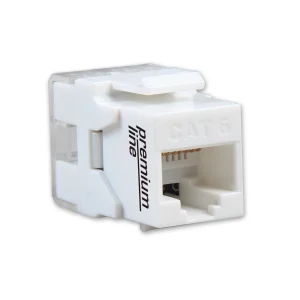In the realm of network infrastructure, the PremiumLine CAT6 Module for Patch Panels stands out as a pivotal component, ensuring seamless connectivity and optimal data transmission. In this comprehensive overview, we delve into the intricate details of this essential networking element, shedding light on its features, benefits, and applications.
Out of stock
In the realm of network infrastructure, the PremiumLine CAT6 Module for Patch Panels stands out as a pivotal component, ensuring seamless connectivity and optimal data transmission. In this comprehensive overview, we delve into the intricate details of this essential networking element, shedding light on its features, benefits, and applications.
At the heart of the PremiumLine CAT6 Module lies a robust architecture designed to meet the demanding requirements of modern networking environments. With meticulous attention to detail, this module adheres to CAT6 standards, guaranteeing high-speed data transmission of up to 1Gbps over copper cabling. Its compatibility with industry-standard patch panels ensures effortless integration into existing network infrastructures, facilitating smooth operation and enhanced performance.
Seamless connectivity forms the cornerstone of efficient networking, and the PremiumLine CAT6 Module excels in this regard. Equipped with advanced shielding mechanisms, this module mitigates external interference, maintaining signal integrity and minimizing data loss. Its compact design and intuitive installation process simplify network deployment, empowering administrators to establish reliable connections swiftly and efficiently.

In the pursuit of optimal network performance, reliability and consistency are paramount. The PremiumLine CAT6 Module embodies these principles, leveraging high-quality materials and precision engineering to deliver unparalleled reliability. By minimizing signal attenuation and crosstalk, it ensures consistent data transfer rates, enabling organizations to maximize productivity and streamline operations.
Versatility lies at the core of the PremiumLine CAT6 Module’s design philosophy, making it a versatile solution for diverse networking environments. Whether deployed in enterprise settings, educational institutions, or residential complexes, this module adapts seamlessly to varying requirements, offering unparalleled compatibility with a wide range of patch panels and networking equipment.
As technology evolves at a rapid pace, future-proofing network infrastructure is essential to accommodate emerging trends and technologies. The PremiumLine CAT6 Module embraces this ideology, incorporating forward-thinking features that anticipate future demands. With support for emerging standards and protocols, it ensures long-term compatibility and scalability, safeguarding investments and positioning networks for sustained growth.
In conclusion, the PremiumLine CAT6 Module for Patch Panels represents a pinnacle of innovation and reliability in the realm of networking infrastructure. With its robust construction, unparalleled performance, and forward-thinking design, it empowers organizations to overcome the challenges of modern networking, facilitating seamless connectivity, and driving productivity. As businesses continue to embrace digital transformation, investing in cutting-edge solutions like the PremiumLine CAT6 Module is imperative to unlock the full potential of their networks and stay ahead in an increasingly interconnected world.

| Brand |
|---|
Reviews
There are no reviews yet.